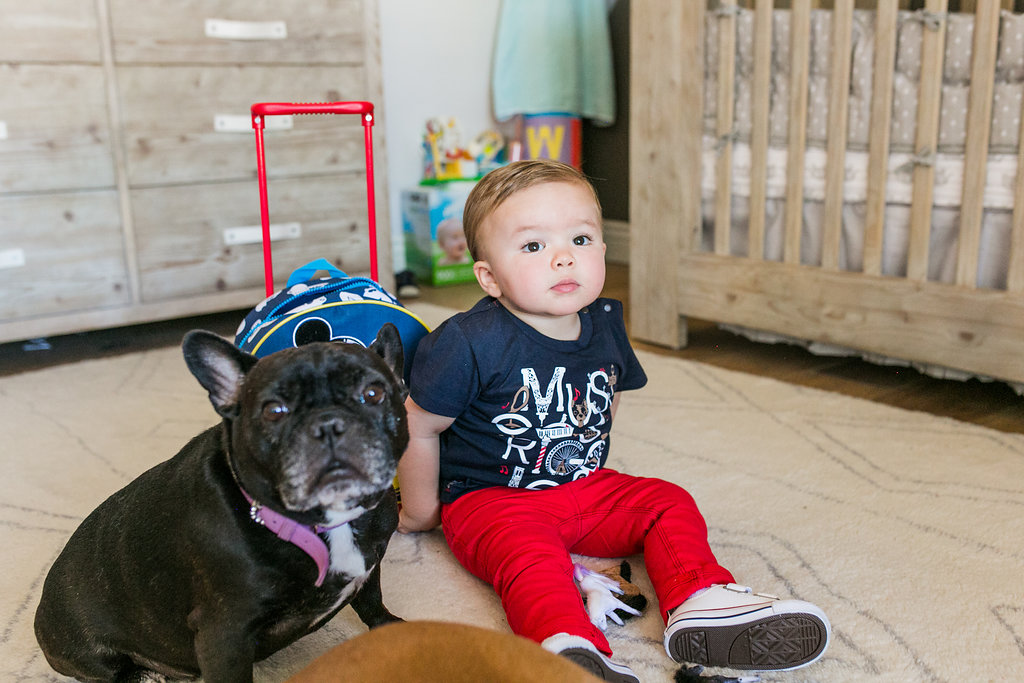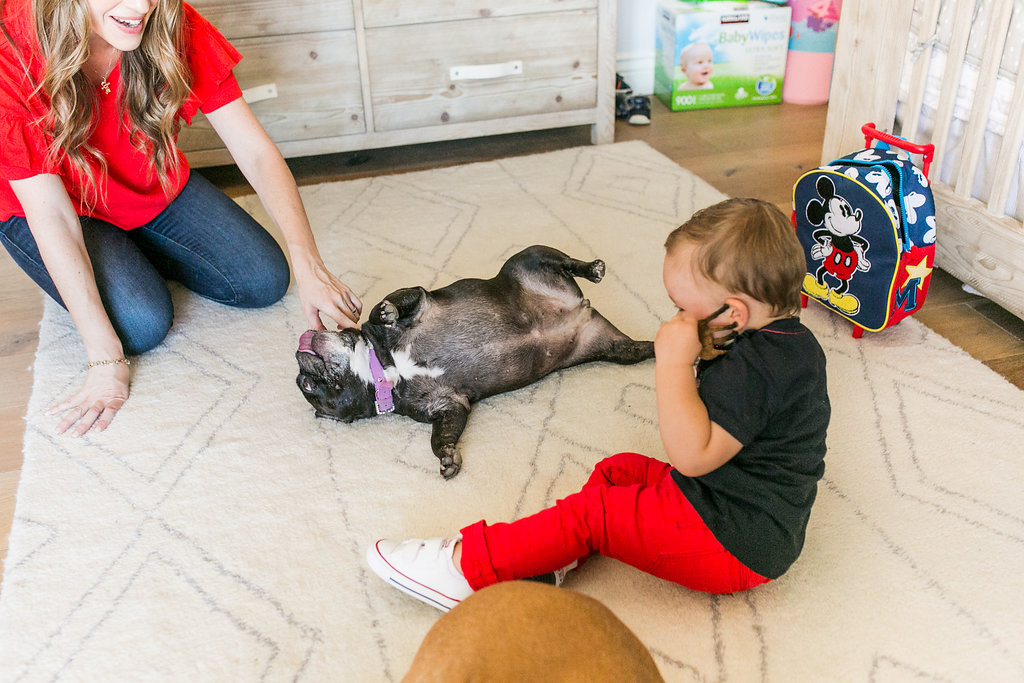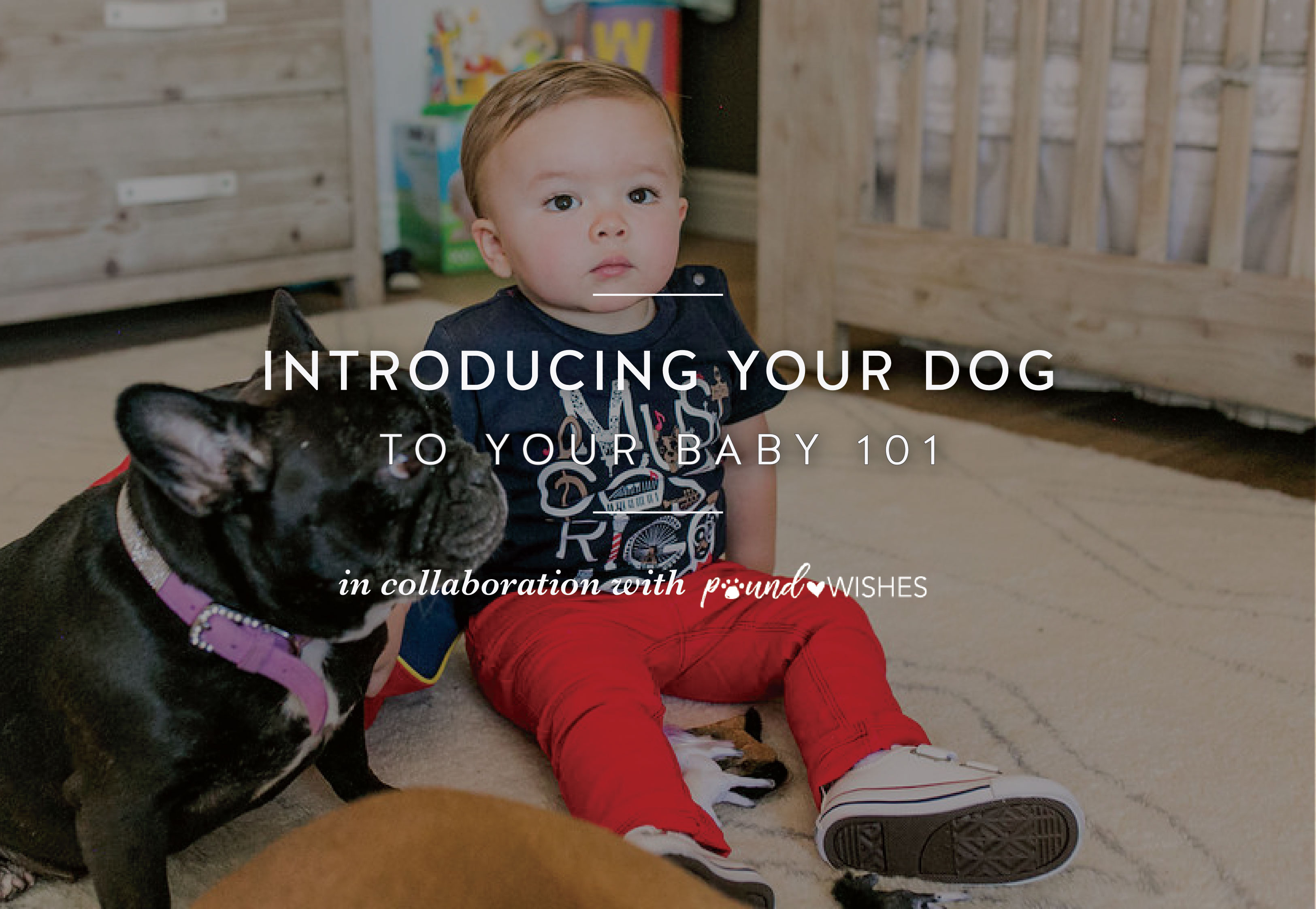
I, like many others, became a dog mom long before having my son.
When I found out I was pregnant, I was over the moon excited and couldn’t wait to welcome him into this world, but there were so many things Dustin & I had to do before he came. One of those things included making sure that our french bulldog would be just as welcoming to Diego as she is to us, and would never hurt him.
It can be a tricky adjustment for new parents, but one of the best things I did was prepare BEFORE Diego arrived. Our animals are often such a big part of our families and as my favorite animal non-profit poundWISHES says, “animals often rescue us.”
Before we even get into prepping your dog for a new baby, let’s actually talk about poundWISHES. They are a fundraising platform and product registry for animals in need of life saving supplies or surgeries. Their website allows you to grant “wishes” for an animal in need and keep up with them along their journey.
These are homeless animals that have missing limbs, were found stranded, were hit by a car, or impacted by other horrific events. They have partnered with over 1,000 shelters to help find and fund medical aid so they can have a second chance with a family and end euthanasia.
What I really love about poundWISHES is that they also help fund behavioral training. Some animals will never get adopted because they were never trained or had to show aggression to survive and they realize that’s a crucial part of adoption.
They have partnered with me on this post to highlight how introducing your favorite furry friend can be easier as you expand your family and bring light to what rescuing a dog can mean.
I had the chance to head straight to an expert and interview K, of Zenergy dog training to learn how she advises parents to introduce their dog to their baby, toddler, or even teen.
She takes a holistic approach of focusing on the intimate relationships we create with our dogs and how we can communicate with them to bring balance to the dynamic. I’m sharing 8 questions for parents about building a healthy dog and child relationship.
Let’s get started!
1. What are the steps to introduce a dog to a baby?
- Establish Leadership
“First of all, before introducing your dog to a baby it is important that you have established a relationship with your dog where they see you as a leader. We must love our dogs through leadership. Establish a relationship in which your dog looks to you for guidance while creating an expectation of respect and politeness. This is accomplished through clear communication that dogs understand, relationship building games that include rules, and structure that removes all off leash freedom or autonomous decision making.”
- Affection Must Be Earned
“In addition, become cognizant of the affection you’re giving your dog. Affection should be earned and reserved for reinforcing desirable behaviors or for a calm state of mind.”
- Permission Is Key
- No Competition
2. How can a parent prepare before the baby comes?
“Introduce the dog to the baby’s scent before the baby comes home. The unfamiliar baby scent often excited a dog. Claim ownership of that scent by allowing the dog to small a blanket with the baby’s scent on it, but do not allow the dog to touch the blank. Dogs can detect a scent from great distances.
The first step to socializing your dog to the baby is teaching your dog to ignore and maintain distance from the baby. Accomplish this with great reliability first. Our definition of a well socialized dog is a dog that can ignore other dogs and people on command.
When our dog has mastered ignoring the baby then we may allow it closer to the baby. But don’t bring the baby to the dog, bring the dog to the baby when it is in a calm state. If the dog becomes excited when approaching the baby, create a bigger stance and go back to having the dog ignore the baby. Never allow a dog to meet a baby in an excited state.”
3. Is there a difference in adopted dogs vs. breed dogs?
Living in human society, no dog is fit to fill that leadership role, which is why we must enforce it. Therefore, loving our dog through leadership is fulfilling an instinctual need, among many others. We must be the source that fulfills all of our dog‘s primal needs in order for our dog to perceive us as it’s leader and want to follow our direction.
But there are THOUSANDS of dogs waiting in shelters to be rescued and are at risk of euthanasia so you can literally save a life by rescuing! We are huge advocates of adopting not shopping.”
4. Is it best to find a dog before or after having a baby?
“It shouldn’t matter as long as the dog recognizes clear leadership from the adult humans in the household.
When the child is old enough the child should be taught how to be a leader in the dog‘s eyes. The dog must recognize all humans in the household as senior members of a hierarchy.
Canine culture in the wild is based on a hierarchy of senior and subordinate members of a pack. Dogs are always communicating with us humans exactly how they communicate with each other. It’s up to us to communicate with them and relate to them in a way they clearly understand.”
5. What should parents never do when introducing a dog to their child?
- Never leave an infant or young child unsupervised with a dog
- Do not allow your dog to play with or have access to the child’s toys
- When your child becomes old enough to play with your dog, have the child play structured games with the dog that include rules, boundaries, and expectations. The dog must not view the child as its playmate. Adding rules to games and play props the child up in the eyes of the dog.
6. Does the child’s age make a difference?
“Yes! Infants should not interact with the dog. The dog should ignore the infant and may have very limited supervised contact for being in a calm state.
7. Are there any breeds that are best for children?
“It depends on your lifestyle. Unless you are very active and want to spend a lot of time working and interacting with your dog, avoid working breeds.
8. What does it mean to have a happy and balanced dog?
“A happy and balanced dog is a dog who’s instinctual needs are being met. Needs can vary from dog to dog, but in every dog‘s heritage is a dog that was bread for work. On top of that, every dog is a descendant of the wolf. Kibble is processed junk food full of sugar. Dogs need a biologically appropriate ancestral raw diet for optimal physical and mental health.
They need perceivable leadership to trust and feel safe.
They need a job that challenges them mentally and instills a sense of purpose.
They need structure that reduces uncertainty and builds confidence.
They need alone time to develop self soothing skills and be able to cope with separation.
They need exercise to burn energy and decompress anxious tension.



